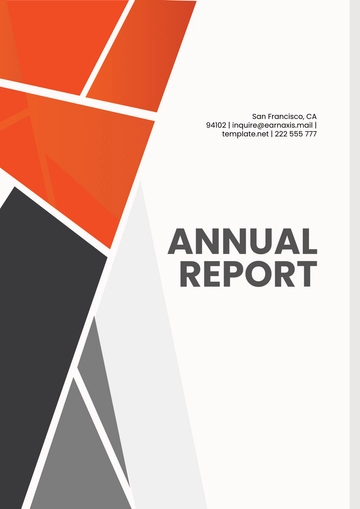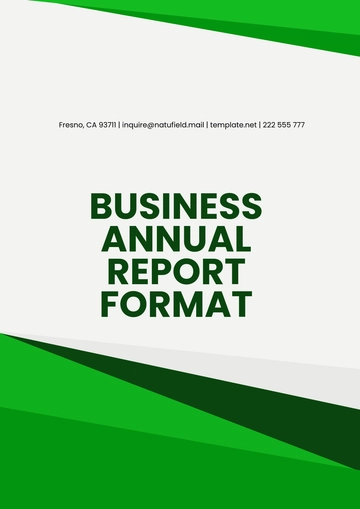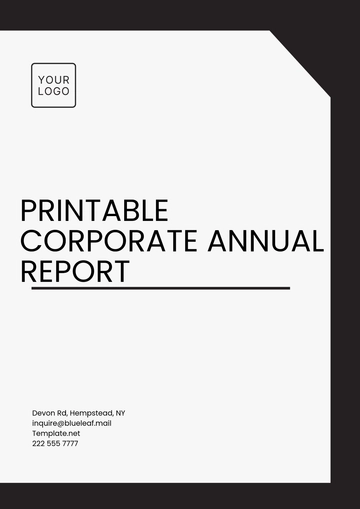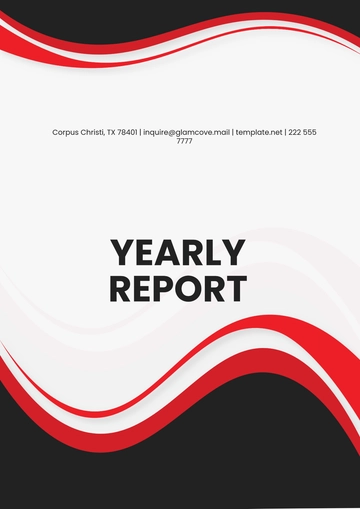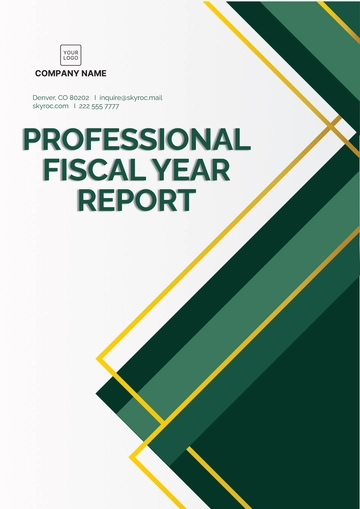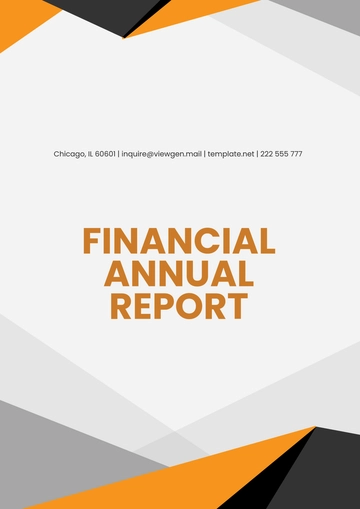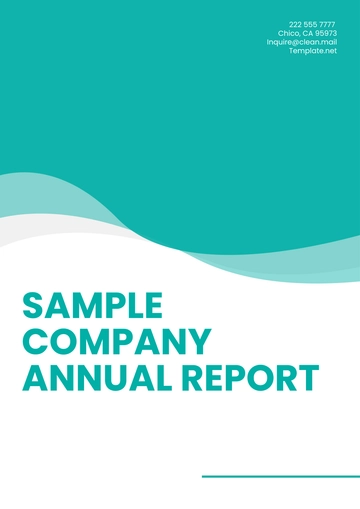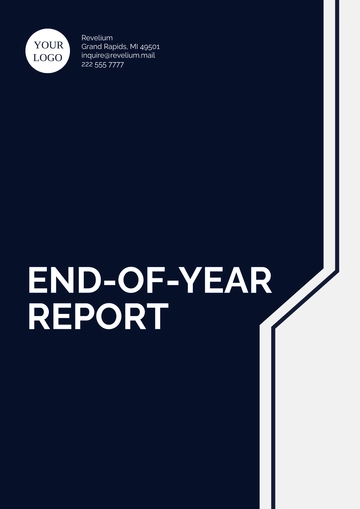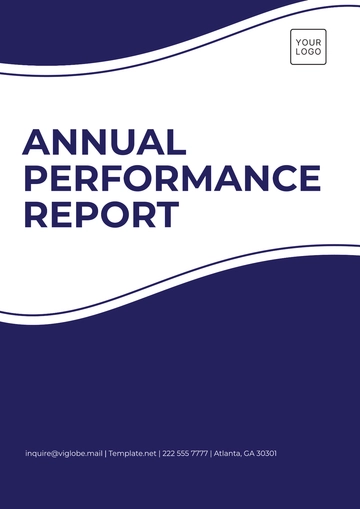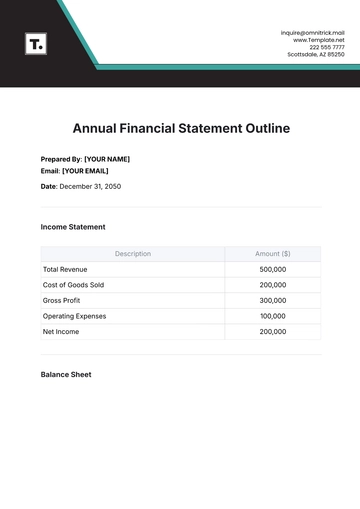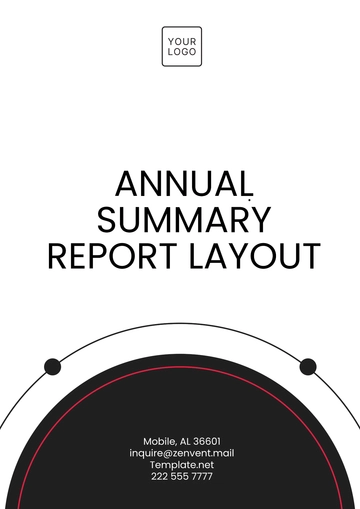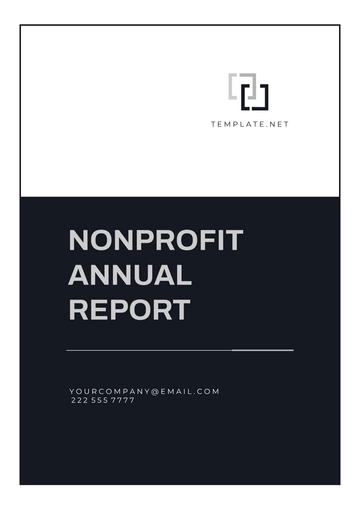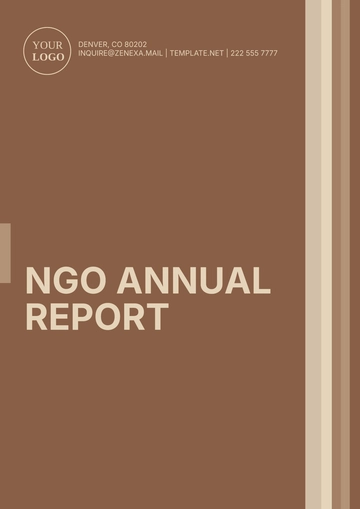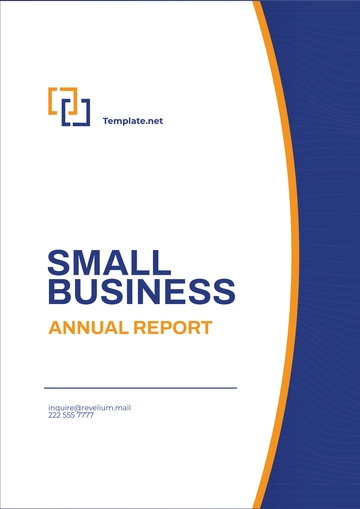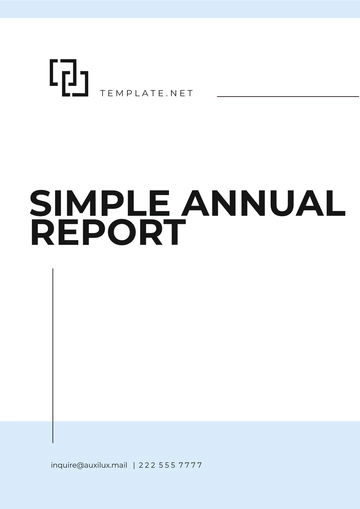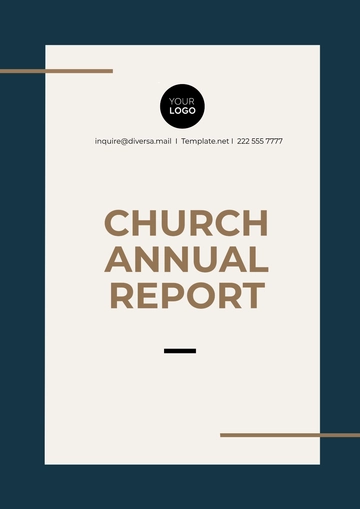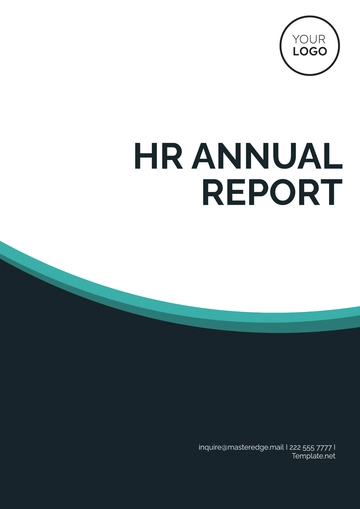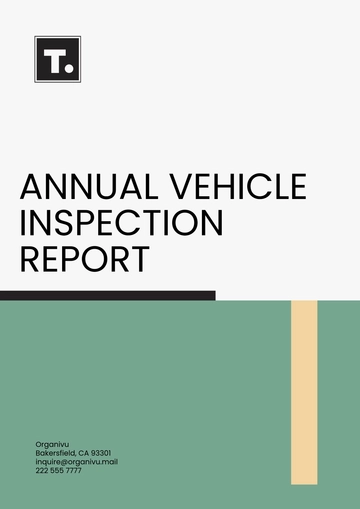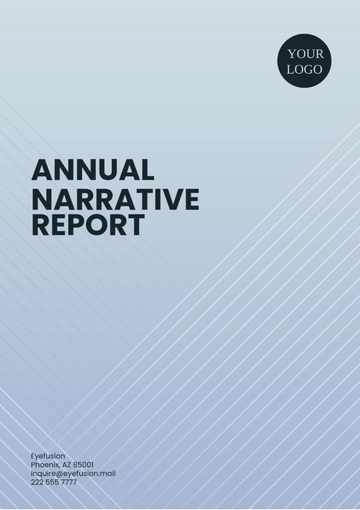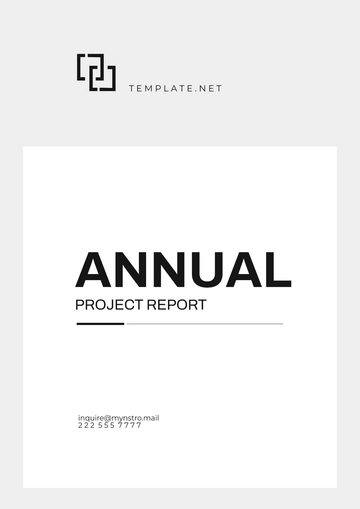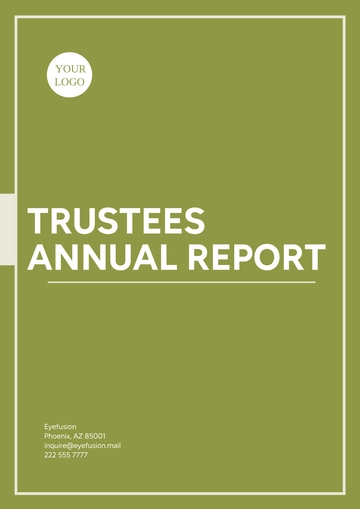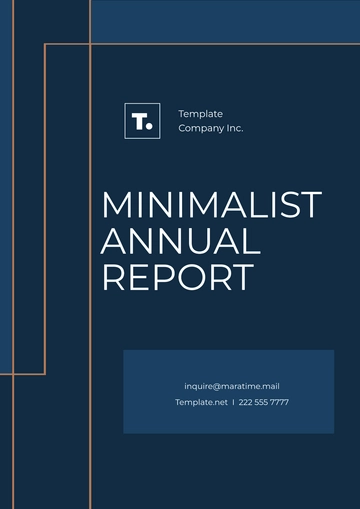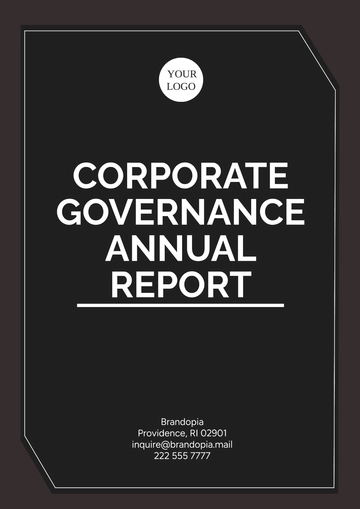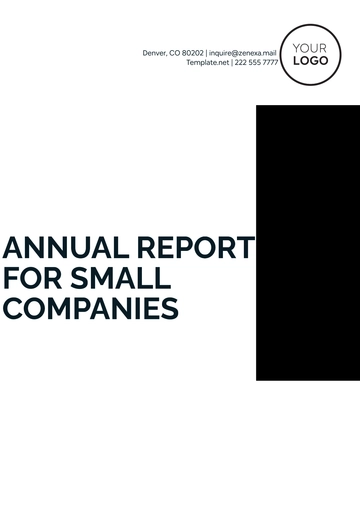Free Comprehensive Annual Financial Report
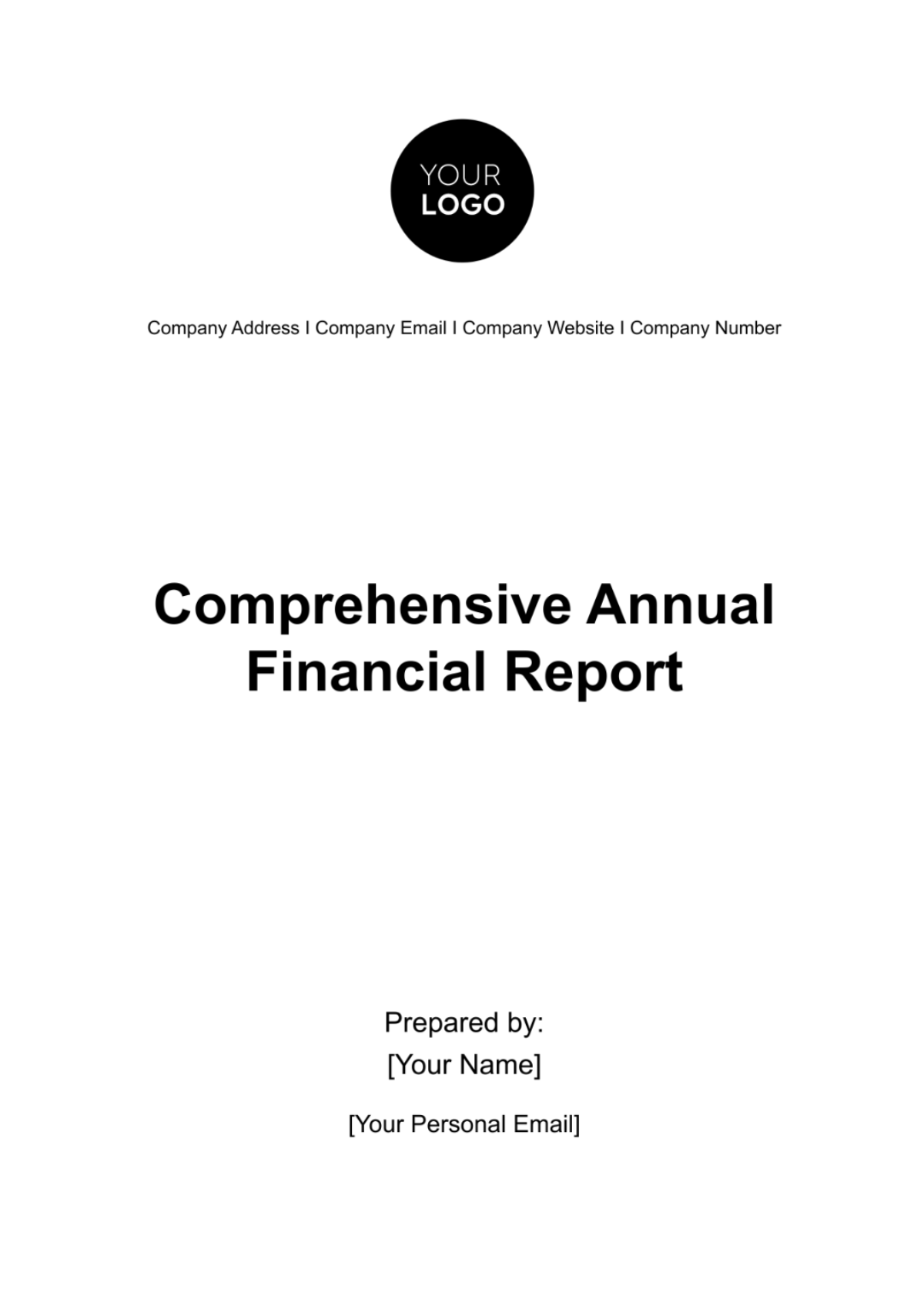
I. Introductory Section
This report serves as a comprehensive overview of our financial journey, encapsulating the performance, activities, and milestones achieved throughout the preceding fiscal year. Emphasizing our unwavering dedication to transparency and accountability, the CAF) stands as a testament to our commitment to open and clear financial communication. Tailored to be a valuable resource, the CAFR is designed to cater to the diverse informational needs of stakeholders, ranging from government officials and citizens to investors and other interested parties. As a cornerstone of effective financial governance, this document aims to provide a nuanced understanding of our financial health and strategic direction.
A. List of Principal Officers
[Name], [Chief Financial Officer (CFO)]
Formulates and oversees the organization's overarching financial strategy, ensuring alignment with its objectives and mission.
Manages financial operations at a strategic level, emphasizing fiscal responsibility and compliance with financial regulations.
Provides leadership in financial decision-making, evaluating risks and opportunities to optimize the organization's financial performance.
[Name], [Finance Director/Manager]
Takes charge of day-to-day financial operations, including budgeting, financial reporting, and long-term financial planning.
Collaborates with department heads to develop and monitor budgets, ensuring financial resources are allocated effectively.
Provides strategic financial insights to support informed decision-making and enhance overall financial health.
[Name], [Accounting Manager/Controller]
Directs and oversees accounting functions, ensuring the accuracy and integrity of financial reporting.
Maintains compliance with accounting principles, implementing and updating policies to reflect regulatory changes.
Manages the financial close process and liaises with external auditors to ensure a transparent and auditable financial record.
[Name], [Budget Director/Manager]
Coordinates the budgeting process, working closely with departments to develop accurate and realistic financial plans.
Monitors budget performance throughout the fiscal year, identifying variances and proposing corrective actions.
Provides financial analysis and insights, aiding leadership in making well-informed decisions aligned with budgetary constraints.
[Name], [Internal Auditor]
Conducts comprehensive internal audits to evaluate the effectiveness of financial controls and ensure compliance.
Assesses operational efficiency and identifies areas for improvement in financial processes.
Collaborates with management to implement corrective actions based on audit findings, fostering continuous improvement.
[Name], [External Auditor]
Represents an external auditing firm entrusted with independently examining the government entity's financial statements.
Conducts a thorough examination of financial records, ensuring accuracy and compliance with accounting standards.
Provides an objective assessment of financial health and adherence to regulatory requirements, contributing to stakeholders' confidence.
[Name], [Chief Executive Officer (CEO)]
Offers overall leadership to the organization, guiding its strategic direction and ensuring the fulfillment of its mission.
Collaborates with the CFO in financial oversight, providing input into key financial decisions and risk management.
Engages in high-level strategic planning, aligning financial goals with the broader objectives of the organization.
II. Financial Section
A. Management's Discussion and Analysis (MD&A)
Overview of Financial Highlights
The table below presents a snapshot of key financial highlights, showcasing the major achievements and areas of focus during the fiscal year.
Financial Metric | Amount | Percentage Change |
Total Revenues | $50,000,000 | 10% |
Expenditures | ||
Net Position | ||
Fund Balance |
It is evident that the company has achieved positive trends across various financial metrics. Total revenues, a pivotal financial metric, stand at an impressive $50,000,000, reflecting a notable 10% increase compared to the previous year. This substantial growth in revenue underscores the organization's financial resilience and effective revenue-generation strategies. The 10% positive change signifies a commendable upward trajectory, suggesting successful financial management and strategic decision-making. The notable increase in total revenues is indicative of the government entity's ability to navigate economic challenges and capitalize on opportunities. This financial milestone not only demonstrates fiscal strength but also signifies prudent resource allocation and revenue diversification efforts. As a key indicator of financial health, the positive percentage change in total revenues reinforces stakeholders' confidence in the organization's economic sustainability.
Economic Outlook
In the face of prevailing global economic challenges, notably the impact of a recession, the entity has demonstrated exemplary resilience and adaptability. Through the implementation of strategic measures and resilient financial planning, the organization has adeptly navigated the complexities of the economic landscape. This ability to withstand the challenges posed by a recession is indicative of the entity's forward-thinking approach and proactive financial management strategies. By maintaining financial stability amidst economic uncertainties, the organization not only safeguards its fiscal integrity but also underscores its commitment to sustainable growth. This resilience speaks volumes about the entity's agility and its capacity to make judicious, informed decisions conducive to long-term economic viability.
Major Initiatives and Challenges
Throughout the fiscal year, the organization proactively implemented major initiatives focused on bolstering public safety and fortifying community resilience. These endeavors underscore the organization's commitment to the well-being of its constituents and the overall stability of the community. Despite these commendable efforts, challenges were encountered, serving as a reminder of the necessity for strategic foresight in overcoming obstacles. The acknowledgment of challenges emphasizes the entity's transparency and dedication to continuous improvement, as well as the recognition that proactive strategies are pivotal for maintaining sustained financial health.
B. Basic Financial Statements
Balance Sheet (Statement of Net Position)
Assets
The table below presents a detailed breakdown of [Your Company Name]'s assets as of [Date].
Category | Amount |
Cash and Equivalents | $10,000,000 |
Investments | |
Accounts Receivable | |
Capital Assets |
In reviewing the balance sheet, it is evident that the entity maintains a strong liquidity position, with a significant portion of assets held in cash and equivalents and prudent investments. Notably, cash and equivalents constitute a substantial portion, totaling $10,000,000. This liquidity in cash and equivalents indicates a robust financial position, offering the organization flexibility in meeting its short-term obligations and capitalizing on strategic opportunities. The significant presence of cash and equivalents suggests a prudent approach to financial management, ensuring the entity's ability to navigate unforeseen challenges. The allocation towards capital assets reflects ongoing investments in infrastructure and facilities to support long-term growth.
Statement of Revenues, Expenditures, and Changes in Fund Balances
Governmental Funds
The table below outlines the revenues, expenditures, and changes in fund balances for [Your Company Name]'s governmental funds during the fiscal year.
Revenue Source | Amount | Expenditures | Beginning Balance |
Taxes | $12,000,000 | $8,000,000 | $20,000,000 |
Analyzing the governmental funds, it is notable that revenues from taxes and charges for services have contributed significantly. Taxes emerge as a noteworthy revenue source, contributing $12,000,000 to the governmental funds, underscoring the entity's robust financial capacity for public initiatives. Simultaneously, judicious financial management is evident with $8,000,000 allocated to expenditures, reflecting a balanced and responsible approach to fund utilization. The $20,000,000 beginning balance contextualizes the fund's financial starting point, setting the stage for the ensuing fiscal activities. Expenditures have been allocated to key areas, with a positive change in fund balance indicating sound financial management. This intricate interplay of revenues, expenditures, and fund balances encapsulates a compelling financial narrative, offering stakeholders valuable insights into the strategic allocation of resources.
Statement of Cash Flows
Operating Activities
The table below presents a breakdown of cash flows from operating activities for [Your Company Name] during the fiscal year:
Operating Activity | Amount |
Cash Receipts from Operations | $18,000,000 |
Payments to Suppliers and Employees | |
Other Operating Cash Flows | |
Net Cash Provided by Operating Activities |
The operating activities stands as a critical component in providing stakeholders with a holistic perspective on the organization's fiscal performance and its ability to navigate the intricacies of operating in a dynamic financial landscape. It reflects the cash generated or used by the entity's day-to-day operations. Notably, cash receipts from operations total $18,000,000, indicating a robust influx of cash generated through the entity's core business activities. This substantial amount reflects the effectiveness of the organization’s operational endeavors, showcasing the organization's ability to generate revenue through its primary functions. The emphasis on cash flows from operating activities underscores a focus on liquidity and the day-to-day financial health of the entity, providing stakeholders with insights into the cash generated and expended in the course of routine operations. The positive net cash from operating activities indicates a healthy operational cash flow, ensuring the entity's ability to meet its short-term obligations.
Investing Activities
The table below outlines cash flows related to investing activities, including purchases and sales of investments and capital assets:
Investing Activity | Amount |
Purchase of Investments | $12,000,000 |
Sale of Investments | |
Capital Expenditures | |
Net Cash Used in Investing Activities |
Investing activities involve the acquisition and disposal of long-term assets. Specifically, the entity engaged in investing activities with a notable expenditure of $12,000,000 for the purchase of investments. This allocation signifies a strategic financial move, indicating the organization's commitment to enhancing its portfolio and potential returns. The significant investment in purchasing assets underscores the organization's forward-thinking approach and willingness to allocate resources for long-term growth. This illuminates the intricate financial maneuvers undertaken by the entity, offering stakeholders a comprehensive view of the strategic investment decisions that contribute to its overall financial health. Additionally, the net cash used in investing activities provides insights into the entity's investment strategy and capital expenditure decisions.
Financing Activities
The table below details cash flows from financing activities, such as the issuance and repayment of debt and other financing transactions:
Financing Activity | Amount |
Issuance of Bonds | $15,000,000 |
Repayment of Debt | |
Other Financing Transactions | |
Net Cash Provided by Financing Activities |
Financing activities reflect the entity's efforts to raise capital and manage its long-term liabilities. the entity engaged in financing activities with the issuance of bonds amounting to $15,000,000. This substantial figure underscores the organization's strategic approach to capital structure and financial leverage. The issuance of bonds serves as a financial instrument to raise capital for various initiatives, reflecting the organization's commitment to securing resources for growth and development. Moreover, the net cash provided by financing activities helps assess the entity's financial leverage and debt management strategies. Overall, these serve as key components for stakeholders, providing a detailed view of the organization's financing decisions, debt management strategy, and its overall approach to sustaining financial health in the long term.
C. Required Supplementary Information (RSI)
Pension and Other Post-Employment Benefit Disclosures
The table below provides detailed information on pension and other post-employment benefits:
Benefit Component | Amount |
Plan Assets | $45,000,000 |
Pension Liability | |
Other Post-Employment Benefits | |
Total Net Pension Liability |
The detailed information provided serves as a transparent account of the organization's dedication to responsible financial planning and ensuring the long-term well-being of its workforce. This disclosure assists stakeholders in assessing the financial implications of employee benefit plans, including funding status, actuarial valuations, and the entity's responsibility for pension and post-employment obligations. The amount of $45,000,000 designated for plan assets underscores the organization's commitment to securing and managing funds dedicated to pension obligations and post-employment benefits. This robust figure in plan assets not only signifies the financial prudence in setting aside resources for future commitments but also indicates a strategic approach to safeguarding the welfare of employees beyond their active service. With the financial data and insights, stakeholders gain a clear understanding of the financial commitments associated with pension and post-employment benefits, contributing to a comprehensive assessment of the organization's financial health and commitment to employee welfare.
III. Statistical Section
A. Financial Trends
Comparative Financial Data
The table below illustrates a [three-year] trend in key financial indicators:
Financial Indicator | [Year - 1] | [Year -2] | [Year -3] |
Total Revenues | $25,000,000 | $30,000,000 | $34,000,000 |
Expenditures | |||
Net Position | |||
Fund Balance |
This consistent upward trend in total revenues reflects the organization's effective revenue generation strategies and prudent financial management. The increase in total revenues indicates a positive financial trajectory, showcasing the entity's capacity to generate income and sustain its operations over the specified period.
Moreover, the observed five-year trend highlights not only the growth in total revenues but also a positive correlation with the net position. The simultaneous increase in both total revenues and net position is indicative of a robust financial position and responsible fiscal stewardship. This alignment underscores the entity’s ability to not only generate revenue but also effectively manage its resources, resulting in an improved overall financial standing.
B. Revenue Capacity
Revenue Capacity Metrics
The following table provides an overview of [Your Company Name]'s capacity to generate revenue:
Revenue Source | [Year - 1] | [Year -2] | [Year -3] |
Property Taxes | $5,000,000 | $5,500,000 | $6,000,000 |
Sales Taxes | |||
Grants and Aid | |||
Other Revenue Sources |
This sustained growth in property tax revenues suggests a robust capacity to generate income from this source, indicating stability and potentially expanding tax bases within the jurisdiction. The steady increase observed across various sources, exemplified by the growth in property tax revenues, signals a well-balanced revenue portfolio. This diversified approach to revenue generation contributes to financial resilience, reducing dependency on a single source and enhancing the organization's ability to adapt to changing economic conditions. The upward trajectory in property taxes, in particular, showcases a positive outlook for sustained revenue capacity, providing stakeholders with confidence in the entity's ability to fund essential services and maintain fiscal stability.
C. Debt Capacity
Debt Capacity Metrics
The table below outlines [Your Company Name]'s ability to manage and service debt over the years.
Debt Metric | [Year - 1] | [Year -2] | [Year -3] |
Outstanding Debt | $15,000,000 | $16,000,000 | $18,000,000 |
Debt Service Payments | |||
Debt-to- Equity Ratio |
This judicious increase in outstanding debt signifies the organization's measured approach to managing its financial obligations, potentially to fund essential projects or capital investments. This analysis is instrumental in evaluating the entity's fiscal responsibility, shedding light on its ability to manage and service debt over time. The combination of a reasonable rise in outstanding debt and consistent debt service payments indicates prudent debt management practices. This approach ensures that the organization can strategically leverage debt to support its initiatives without compromising its long-term financial stability. Stakeholders can interpret these debt capacity metrics as indicators of the entity's commitment to responsible fiscal practices, contributing to a balanced financial framework that allows for strategic investments while maintaining a manageable level of debt.
D. Demographic and Economic Information
Population Trends
The table below illustrates the population growth or decline in [Your Company Name]'s jurisdiction over the past decade.
Current Year | [Year - 2] | [Year -4] | [Year -6] | [Year -8] | [Year -10] |
68,000 | 60,000 | 57,000 | 53,000 | 49,000 | 45,000 |
Population trends are critical factors in anticipating and addressing the evolving demands on public services. Population trends are critical factors in anticipating and addressing the evolving demands on public services. A growing population, as reflected, implies increased needs for essential services such as healthcare, education, and infrastructure.
These population insights provide valuable guidance for the organization in developing sustainable policies and infrastructure that align with the evolving needs of its residents. By closely examining these demographic shifts, we can proactively engage in urban planning, addressing housing, transportation, and employment needs. This multifaceted understanding of population dynamics aids the organization in fostering a resilient and thriving community, ensuring that its initiatives are not only reactive but also anticipatory, contributing to the overall well-being and sustainability of the jurisdiction.
Economic Indicators
The following table provides key economic metrics shaping the local economy, including employment rates, GDP growth, and industry trends:
Economic Indicator | [Year - 1] | [Year -2] | [Year -3] |
Unemployment Rate | 5% | 4.5% | 4% |
GDP Growth Rate | |||
Leading Industry Contributions |
Understanding and monitoring economic indicators are essential for making informed decisions, allocating resources effectively, and proactively addressing challenges and opportunities in the industry. These indicators provide a comprehensive view of the local economy, informing strategies for economic development, resource management, and policy formulation. The presented unemployment rates showcase a positive trend, decreasing from 5% in the past year to 4.5% two years ago and further down to 4% three years ago. This declining trend in unemployment rates signifies a strengthening job market and enhanced economic stability.
A lower unemployment rate typically corresponds to increased employment opportunities, contributing to improved living standards and economic vitality within the jurisdiction. It suggests that the community is experiencing sustained economic growth, as reflected in the decreasing number of unemployed individuals. This positive economic momentum bodes well for the overall well-being of the residents, fostering a more prosperous and stable socio-economic environment. The organization can leverage these encouraging economic indicators to inform strategic initiatives that align with the evolving needs of its workforce and ensure continued economic prosperity for the community. By staying attuned to economic shifts, the organization can enhance its ability to respond dynamically to the needs of the community and foster sustained economic well-being.
- 100% Customizable, free editor
- Access 1 Million+ Templates, photo’s & graphics
- Download or share as a template
- Click and replace photos, graphics, text, backgrounds
- Resize, crop, AI write & more
- Access advanced editor
Present financial data seamlessly with our Comprehensive Annual Financial Report Template from Template.net! This editable and customizable template simplifies the annual reporting process, ensuring clarity and precision. Elevate your financial reporting standards with a tool designed for professionalism and accuracy. Tailor effortlessly using our AI Editor Tool! Try it today!
You may also like
- Sales Report
- Daily Report
- Project Report
- Business Report
- Weekly Report
- Incident Report
- Annual Report
- Report Layout
- Report Design
- Progress Report
- Marketing Report
- Company Report
- Monthly Report
- Audit Report
- Status Report
- School Report
- Reports Hr
- Management Report
- Project Status Report
- Handover Report
- Health And Safety Report
- Restaurant Report
- Construction Report
- Research Report
- Evaluation Report
- Investigation Report
- Employee Report
- Advertising Report
- Weekly Status Report
- Project Management Report
- Finance Report
- Service Report
- Technical Report
- Meeting Report
- Quarterly Report
- Inspection Report
- Medical Report
- Test Report
- Summary Report
- Inventory Report
- Valuation Report
- Operations Report
- Payroll Report
- Training Report
- Job Report
- Case Report
- Performance Report
- Board Report
- Internal Audit Report
- Student Report
- Monthly Management Report
- Small Business Report
- Accident Report
- Call Center Report
- Activity Report
- IT and Software Report
- Internship Report
- Visit Report
- Product Report
- Book Report
- Property Report
- Recruitment Report
- University Report
- Event Report
- SEO Report
- Conference Report
- Narrative Report
- Nursing Home Report
- Preschool Report
- Call Report
- Customer Report
- Employee Incident Report
- Accomplishment Report
- Social Media Report
- Work From Home Report
- Security Report
- Damage Report
- Quality Report
- Internal Report
- Nurse Report
- Real Estate Report
- Hotel Report
- Equipment Report
- Credit Report
- Field Report
- Non Profit Report
- Maintenance Report
- News Report
- Survey Report
- Executive Report
- Law Firm Report
- Advertising Agency Report
- Interior Design Report
- Travel Agency Report
- Stock Report
- Salon Report
- Bug Report
- Workplace Report
- Action Report
- Investor Report
- Cleaning Services Report
- Consulting Report
- Freelancer Report
- Site Visit Report
- Trip Report
- Classroom Observation Report
- Vehicle Report
- Final Report
- Software Report
